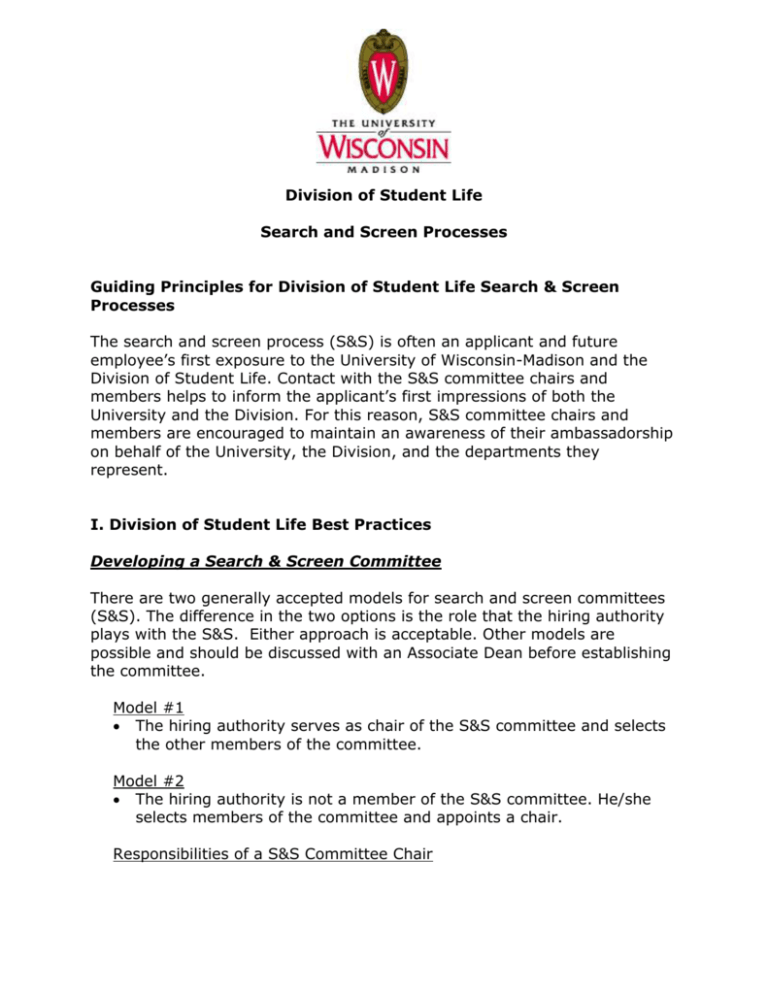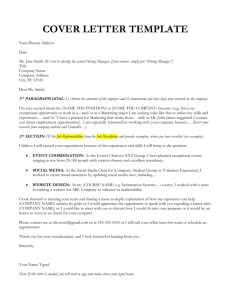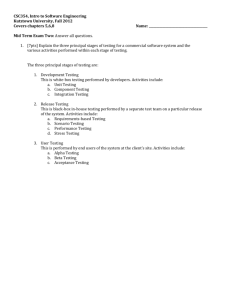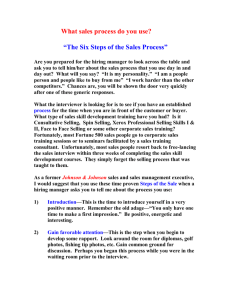Search and Screen Toolkit - Division of Student Life
advertisement

Division of Student Life Search and Screen Processes Guiding Principles for Division of Student Life Search & Screen Processes The search and screen process (S&S) is often an applicant and future employee’s first exposure to the University of Wisconsin-Madison and the Division of Student Life. Contact with the S&S committee chairs and members helps to inform the applicant’s first impressions of both the University and the Division. For this reason, S&S committee chairs and members are encouraged to maintain an awareness of their ambassadorship on behalf of the University, the Division, and the departments they represent. I. Division of Student Life Best Practices Developing a Search & Screen Committee There are two generally accepted models for search and screen committees (S&S). The difference in the two options is the role that the hiring authority plays with the S&S. Either approach is acceptable. Other models are possible and should be discussed with an Associate Dean before establishing the committee. Model #1 The hiring authority serves as chair of the S&S committee and selects the other members of the committee. Model #2 The hiring authority is not a member of the S&S committee. He/she selects members of the committee and appoints a chair. Responsibilities of a S&S Committee Chair The chair typically manages the process of organizing the committee meetings; developing forms, agendas, leading conversations and managing the hiring process. Responsibilities of a Hiring Authority The hiring authority is always expected to provide the S&S committee a charge. It is preferred that this is done at the first committee meeting and in person if possible. The charge: a. Outlines the committee’s responsibilities b. Provides information on what qualities, experiences, skills, etc. to look for in applicants c. Guidelines such as : a target number of finalists to bring to campus, specifications on who or what groups of people a finalist should meet while on campus d. A clear understanding of when the hiring authority wants to be included in the process e. The format in which the finalists are presented to the hiring authority (i.e. ranking or unranked) Making the final decision to extend a job offer to a candidate. Provide a budget for the search and screen process. Search & Screen Chair Checklist There are many details that an S&S chair, whether the hiring authority or an appointed individual, needs to keep in mind regarding organizing the committee. While not an exhaustive list, some of those include: 1. Review the WISELI, APO and ODOS Tool Kit resources 2. Meet with the ODOS Central Administration Human Resources (HR) staff member to: a. Determine levels of interest letters (as detailed in the Tool Kit) b. Prepare for feedback to rejected candidates c. Review screening policies/expectations and develop understanding of the HR staff member’s responsibilities in the screening process d. Reaffirm confidentiality standards, particularly for internal candidates 3. Check any budget limitations for candidates coming to campus*** 4. Determine if the position be recruited for at a conference? If yes, what is the plan to integrate that into the process? 5. Arrange for hiring authority to discuss search process expectations and give the charge to the committee 6. Identify critical stakeholders to possibly serve on the committee.*** 7. Facilitate communication amongst the committee members*** 8. Develop the agenda for committee meetings. The agenda for the first meeting should include: a. Introductions b. Committee charge c. Timeline d. Review process e. Meeting schedule f. Forecasting topics covered in future meetings i. Interview Question development 1. For Paper (resume/cover letter review) 2. For telephone interviews 3. For campus interview ii. Schedule for Interview days iii. Hosting the candidate *** To be completed in consultation with the hiring authority. Shared Governance and Students on Search & Screen Committees Students are at the center of what the Division of Student Life does. For that reason, it is desirable that students be active participants in Search & Screen processes. Utilizing the ASM Shared Governance appointment process is one way to achieve this goal. You may have specific students in mind because they are familiar with the Department and the duties of the specific position. If you invite a student to participate outside of the ASM appointment process, it is recommended, but not required, that you submit names of students you contact to the ASM Shared Governance committee so they can be officially appointed. Please refer to the Division of Student Life policy on appointing students to Search Committees on the Division’s intranet. Advertising and Recruitment Because both the University and the Division of Student Life are committed to having a vibrant, diverse workforce, it is desirable to achieve as diverse a pool of qualified applicants as possible. As the S&S chair, one of the most important steps to consider is advertising and recruitment of applicants. The Division’s HR staff person will assist with some advertising (typically the Chronicle of Higher Education) but it is incumbent upon the S&S committee to identify other venues which may attract a diverse pool. The WISELI manual can be helpful in this regard, but it may also be beneficial to work with other Directors in the Division of Student Life, who might be able to assist in promoting a position through their field’s websites and list serves. Communication With Applicants ODOS has set the following standards for communication with candidates: 1) Applicants All applications from candidates are acknowledged in writing by the Division’s HR staff person. A template/sample of that letter is in the toolbox. Additional information can be included in this letter at the chair’s discretion. The chair should speak to the HR staff person to coordinate the acknowledgement letter content. 2) Candidates not advanced to telephone or on-site interviews If a candidate is not short-listed for either a telephone or, later on, for an on-site interview, the applicant will be sent a letter by the Division’s HR staff person communicating where they are in the process. The letter may convey either that the applicant is no longer under consideration or that they remain under consideration but are not currently being advanced to an interview. Templates/samples of those letters are in the toolbox, and again, can be altered to fit the search committee’s needs by working with the Division’s HR staff person. 3) Candidates not selected after telephone interview. It is the responsibility of the S&S committee to find out the applicant’s preferred method of being contacted (phone or e-mail) for follow-up after a telephone interview. If a candidate is offered a telephone interview and is not advanced to the next round, the applicant should be notified by the S&S committee chair based on their preference. An official follow-up letter will be sent by the HR staff person once the S&S committee chair has indicated they’ve made initial contact. 4) Candidates not selected after an on-site interview. If a candidate is brought in for an on-site interview and is not offered the position, the candidate should be notified, as indicated by preference of the applicant, by the hiring authority. The HR staff person will follow-up with an official non-select letter once the hiring authority has indicated they’ve made initial contact. 5) Candidate feed back Candidates not advanced or offered a position may seek feedback; or have questions about their progress through the search and screen process. In this event they should be directed to the S&S Chair. The Chair should first consult with the Division’s HR staff person and hiring authority before having this conversation. Hiring Process 1. Once a successful candidate has been identified through the S&S process the hiring authority will make an official job offer to the candidate pending a successful criminal background check. The first stage of the offer is typically done via a phone call. 2. If the candidate verbally accepts the position, then the HR staff person will contact the candidate in order to run a criminal background check. Per system policy, all hiring is contingent upon successful completion of this background check. 3. Assuming the background check is successful, the candidate will be sent a letter officially offering the position. The candidate must accept reply back with their written acceptance. Moving Expenses Moving expenses can be offered or requested by a person when a hiring offer is being extended. The provision of moving expense and the amount is at the discretion of the hiring authority. The decision is dependent upon available funds, the type of position, and the nature of the candidate’s moving expenses. The division has not set any standards for moving expenses however, there are state and UW system guidelines that must be followed (see appendix). New Employee Orientation Orientation of a new employee is critical to their success and is the responsibility of their immediate supervisor. The S&S toolkit contains a new employee checklist which outlines topics that should be addressed with all new divisional staff. Departments can add to this list as needed. In addition to departmental orientation the following interactions occur at the divisional level: Once a hire is official the hiring authority should contact the HR staff person. The HR staff person will relay the information about the new hire to the Special Assistant to the Dean and to the Dean. All new employees will receive an official welcome letter from the Dean prior to their start date. Shortly after their first day of work a new employee should contact the Executive Assistant to the Dean in order to set up a welcome with the Dean and their respective Associate Dean. At those meetings they will receive an overview on the division. The Role of the Division of Student Life HR Staff Person The Division of Student Life HR staff person plays an important role in keeping S&S processes moving forward, maintaining consistency, and adherence to campus, system and state procedures. Often there are multiple searches occurring across the division at the same time. It is highly recommended that the hiring authority and the S&S chair meet with the HR staff person prior to beginning a search in order to discuss the timeline and process. The major responsibilities of the HR staff person in regards to S&S processes include: Submit an approved (by Dean or Associate Dean) position description for posting the position. Work with hiring authority on application deadline dates, begin dates, posted salary, etc. Send acknowledgement and non-select letters to applicants during the S & S process. Send a Criminal Background Check to the selected candidate. Meet individually with all new-hires for HR and benefits introduction. II. Campus Resources There are useful resources which should be reviewed by both the hiring authority and the S&S chair prior to beginning a process; in addition, much of the information contained in these resources can and should be shared with S&S committee during the first committee meeting. Note that both the WISELI manual and the OHR website (both discussed below) offer guidelines on questions that cannot be asked: 1) Office of Human Resources Academic Personnel Office Search Handbook http://www.ohr.wisc.edu/polproced/srchbk/sbkmain.html a. The University of Wisconsin’s Office of Human Resources (OHR) Academic Personnel Office (APO) Search Handbook provides an excellent overview of the entire S&S process. APO Search Handbook has two basic sections; the first section provides advice and guidelines for the search process, from definitions that the entire S&S committee should know to how the hiring supervisor should craft the S&S committee charge, to suggestions on how to run the process, hold interviews, and make recommendations to the hiring supervisor. The first section ends with guidelines for the supervising on how to make an offer, and thoughts on retaining women and minority faculty and staff. b. The second half of the APO handbook is a series of appendices which includes supplemental information on everything from policies to sample documents, to the “dos and don’ts” of interview questions. Some information in the appendices is useful only to the hiring supervisor and the ODOS HR staff, while others can and should be used as a resource for committee members. 2) Women In Science & Engineering Leadership Institute (WISELI) http://wiseli.engr.wisc.edu/initiatives/hiring/SearchBook.pdf a. The Women In Science & Engineering Leadership Institute at the University of Wisconsin has developed an excellent resource for establishing and managing a Search & Screen committee based on a commitment to excellence and diversity in the entire S&S process, from a diverse committee membership to recruiting a diverse and talented pool of applicants to the screening process. As is made clear in the introduction, the WISELI handbook is meant not to replace the APO Search Handbook, but to supplement it. It begins with a section providing advice to both the hiring supervisor and the S&S chair on how to create and run an effective and efficient committee and continues with a section on how to actively recruit a diverse applicant pool. One of the most helpful sections in the WISELI handbook also offers the most challenge and opportunity, because the S&S committee itself must become, to some extent, a learning community, given to examining unconscious influences and biases that may be held by members of the search committee, in order to ensure a fair and thorough review of candidates. Finally, the WISELI handbook ends with the interview process and advice on how to evaluate finalists in a fair and unbiased manner. b. The WISELI handbook is long, detailed and filled with many supplemental resources; while it’s unlikely that the hiring supervisor and the S&S committee chair can actually use the handbook for an extensive training program prior to the work of the S&S committee, it can and should be referred to, referenced and shared extensively with committee members. c. Finally, while the WISELI handbook offers sample documents and supplemental resources, additional sample documents, timelines, evaluation tools and rubrics, etc., developed by various ODOS units can be found in the Tool Kit. 3) Disability Resources a. Resources to help employers be more effective at recruiting individuals with disabilities are available in many places. More information on recruitment of individuals with disabilities can be found at: http://www.diversityworld.com/Disability/recruit.htm b. UW-Madison is committed to providing reasonable accommodations to permit employees access to employment, programs, activities and facilities as required by the Americans with Disabilities Act (ADA). More information from the Office for Equity and Diversity can be found at: http://www.oed.wisc.edu/disability/ c. Neither the APO nor the WISELI handbooks (discussed later in this document) offer detailed advice on recruiting and working with applicants with disabilities. The APO handbook has two appendices on “Employment Provisions of the ADA” and “UWMadison Disability Accommodation Flowchart”. The flowchart uses the term “employee/applicant” but the approach offered is more one of addressing the topic from a perspective of legal liability, rather than an openness to diversity in the Search & Screen process. The Office for Equity and Diversity website listed above offers some information. 4) US Department of Education a. http://www.ed.gov/about/offices/list/osers/products/employmen tguide/disabilityemployment101.pdf 5) UW System Relocation Expenses a. http://www.bussvc.wisc.edu/acct/trreloc.html III. Tool Kit Sample documents developed through past Division of Student Life search and screens are included in this toolkit; additional sample documents can be found in the WISELI manual, the Division’s HR staff person, and from directors of the various departments. 1) Templates of Divisional HR letters a. First Acknowledgement b. Holding Pool c. Non-Select 2) Timetables of searches a. Local b. Regional/National 3) Sample Questions (can be obtained from the Division’s HR staff person). a. Phone Interviews b. On-site Interviews c. Reference Checks 4) Interview Day – Sample Agendas a. Sample of interview day agenda 5) New Employee Checklist: The following checklist is a sample that can be used for newly-hired employees as a guide during their first days on campus. a. New Employee Checklist (Divisional) b. New Employee Checklist (OHRD) Policies and Procedures 3.01





